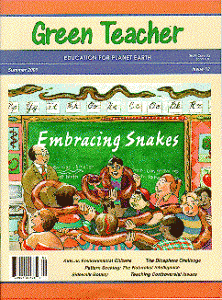Green Teacher 62, Summer 2000
 Features
Features
There’s a Snake in My Classroom by David Tonetti
Though it may surprise some, snakes can be an ideal classroom pet. This article focuses on the educational advantages of keeping a snake in the classroom, and offers useful guidelines on how to raise them.
The Biosphere Challenge: Developing Ecological Literacy by James (Jimmy) W. Karlan
An adaptation of various professional attempts to sustain life in sealed environments, the biosphere activity challenges students of all ages to rethink their most fundamental ideas about nature. In the process, they learn some principles about ecology.
From Pattern to Principle: Discovering Science Through Observing Patterns in Nature by Robert Barkman
Asking students to observe patterns in nature, rather than to just memorize theories, encourages them to construct the big ideas of science on their own, and to better develop their “naturalist intelligence.”
Young Children as Environmental Citizens by Carole Basile and Cameron White
While exploration and discovery are seen by educators of young children as the precursors to building environmental literacy, a key component of environmental literacy is citizenship. This article shares a number of ways that environmental educators can help young students lay a foundation for moving towards issue investigation and action.
Zoning Out: Intertidal Inquiry by Terry Parker
Beach walks with students can be an opportunity for teachers to explore a variety of environmental concepts and themes with their students.
Teaching Controversial Issues (reprint) by Pat Clarke
A four-step classroom strategy for clear thinking on controversial issues.
Sidewalk Botany (reprint) by Sandra K. Reidel
Rediscovering nature on our doorsteps, vacant lots and alleys can open a kaleidoscope of educational opportunities.
Where’s the Future in Teaching? (reprint) by David Ferns
Creating a citizenry capable of working towards change requires education that is as much about the future as it is about the past and present.
The 200-Year Present excerpted from Educating for the Future: A Practical Classroom Guide, by David Hicks.
This teaching activity helps children aged 10-16 explore relationships between past, present and future, and to develop a sense of chronology.
Rights of Future Generations excerpted from Educating for the Future: A Practical Classroom Guide, by David Hicks.
This teaching activity helps children aged 12-18 understand that future generations have needs, and therefore rights, similar to their own.
Blowing Up Your World (reprint) by Jean Harding
A highly visual activity for grades 4-10 that focuses on individual responsibility for saving the planet.
And as always, over 20 new educational resources are profiled and evaluated in this issue of Green Teacher.
Leave a Reply
You must be logged in to post a comment.





